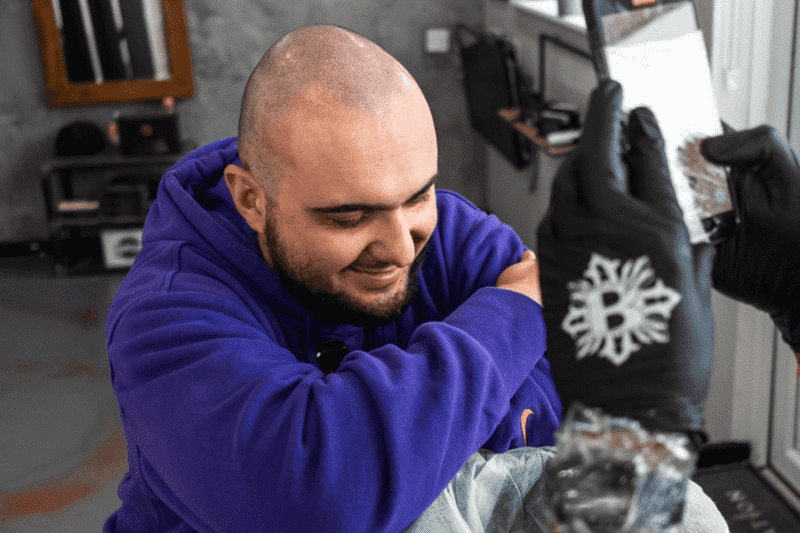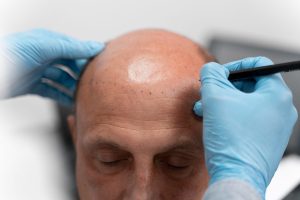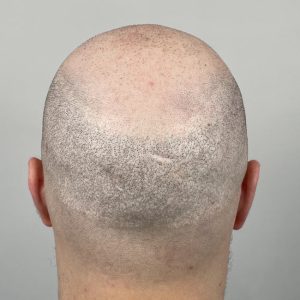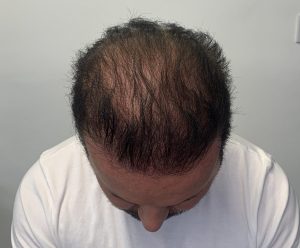Male pattern baldness follows predictable patterns, not random chaos. The norwood scale provides a standardized framework for measuring hair loss severity across seven distinct stages. Developed in the 1950s and refined over decades, this classification system helps doctors, specialists, and men themselves understand exactly where they stand. Knowing your stage shapes treatment decisions, sets realistic expectations, and clarifies which restoration options make sense for your specific pattern.
Key Takeaways
- The norwood hair scale breaks male pattern baldness into seven stages, from minimal recession to advanced loss
- Stages 1-2 represent little to no balding, while Stage 3 marks the clinical threshold where intervention becomes relevant
- Your current stage determines which treatments work best—medications suit early stages, while permanent solutions address advanced patterns
- Professional assessment beats self-diagnosis because subtle factors like donor density and scalp health matter beyond visual patterns
- Scalp micropigmentation delivers results at any Norwood stage, creating natural-looking density without surgery
What Exactly Is the Norwood Scale?
Dr. James Hamilton first studied male baldness patterns in the 1950s. Two decades later, Dr. O’Tar Norwood refined Hamilton’s work, creating the classification system that bears his name. The result? A diagnostic tool that captures how androgenetic alopecia—male pattern baldness—typically progresses.
The norwood hair scale tracks recession patterns starting at the temples and monitors crown thinning. Most men lose hair in these specific zones rather than experiencing uniform thinning. This predictable progression lets specialists diagnose your current state and estimate future changes.
Doctors rely on this system because it creates shared language. When a specialist mentions “Norwood 4,” both patient and practitioner understand precisely what that means. The scale bridges communication gaps that vague descriptions like “moderate thinning” create.
The Norwood system specifically captures male androgenetic alopecia—the condition responsible for roughly 95% of hair loss in men.
How Do the Seven Norwood Stages Actually Progress?
Stage 1: The Baseline
Full coverage with no recession. Some fortunate men maintain Stage 1 throughout their lives. This represents your hair before genetics trigger any follicle changes.
Stage 2: The First Signs
Your hairline pulls back roughly 1-2 centimeters. Most adult men naturally reach this “mature hairline” with slight temple recession. Many spend decades here without further progression.
Stage 3: When Baldness Becomes Obvious
Deep M-shaped recession appears at the temples. Some men also develop crown thinning (Stage 3 Vertex). Specialists consider this the first level of clinical baldness, where many start exploring treatment options.
Stage 4: Noticeable Progression
Significant loss spreads across temples and frontal area with a distinct crown bald spot. A band of hair still connects these areas—this bridge distinguishes Stage 4 from more advanced patterns.
Stage 5: The Bridge Starts Breaking
The frontal and crown bald areas begin merging as the connecting band thins. The classic horseshoe pattern emerges as coverage retreats toward sides and back.
Stage 6: Extensive Loss
The bridge disappears completely, creating one large bald area on top. Hair remains relatively dense on sides and back, forming the unmistakable horseshoe shape.
Stage 7: Most Advanced
A thin band wraps around the skull base. The remaining hair tends to be fine and sparse. Donor hair for transplants becomes limited, though treatment options don’t disappear entirely.
Class A Variation: Some men experience uniform recession from front to back without typical vertex balding.
Why Does Your Norwood Stage Matter for Treatment Choices?
Early-stage patterns respond well to medications. Finasteride blocks DHT production. Minoxidil stimulates blood flow to follicles. Both work best when you still have hair to maintain. Waiting until Stage 6 makes medications largely ineffective because they can’t resurrect dead follicles.
Mid-stages offer maximum flexibility. At Norwood 3 or 4, you can choose between hair transplants, scalp micropigmentation for men, medications, or combination approaches. You have donor hair available. Remaining follicles still respond to treatments. This window creates opportunities that close at more advanced stages.
Advanced patterns require strategic thinking. Hair transplant surgeons must calculate whether sufficient donor hair exists to cover large bald areas. Some men at Stage 6 or 7 choose scalp micropigmentation because it works regardless of donor availability. The buzz-cut aesthetic suits many lifestyles. Results appear immediately, unlike transplants that require months to show growth.
Cost considerations shift by stage:
- Medications demand ongoing expenses ($30-80 monthly, indefinitely)
- Transplants at Stage 3 need fewer grafts than Stage 6 (lower initial cost)
- SMP pricing remains relatively consistent across stages
- Waiting too long can make certain options financially impractical
Time investment changes too. Medications require daily application for life. Stop taking them, and you resume losing hair. Transplants involve one major procedure followed by a year-long wait for results. Scalp micropigmentation typically completes in three sessions over 30-45 days, delivering permanent results without daily maintenance.
Can You Accurately Identify Your Own Norwood Stage?
Taking photos from multiple angles—straight-on, from above, and both sides—provides clues. Compare images from six months ago to track progression. Temple recession becomes easier to spot when you document changes.
Self-assessment has limits. Lighting affects how much scalp shows through thinning hair. Your own bias clouds objective evaluation. Two men at identical Norwood stages might look different based on hair color and scalp tone.
Professional assessment captures invisible factors. Hair thickness matters tremendously. Donor area evaluation becomes critical for transplant planning. Will Quaye’s qualifications as both a Level 4 Scalp Micropigmentation Artist and Clinical Trichologist create an advantage—the trichology background means understanding scalp health and miniaturization patterns beyond aesthetics alone.
Advanced diagnostic tools reveal details mirrors can’t show. Trichoscopy magnifies individual follicles. Scalp mapping tracks density across zones. A free consultation eliminates guesswork, replacing it with data-driven staging.
What Solutions Work Best at Different Norwood Stages?
Stages 1-2: Prevention and Monitoring
Action at this point feels premature to many men. Fair enough. But if hair loss runs in your family, early monitoring helps. Take quarterly photos. Track whether your Stage 2 mature hairline stays stable or continues retreating. Some men choose preventive medications, though side effects make this controversial for minimal recession.
Lifestyle modifications support overall scalp health:
- Balanced nutrition with adequate protein, iron, and biotin
- Stress management since cortisol accelerates certain types of shedding
- Gentle hair care avoiding excessive heat styling or tight hairstyles
- Regular scalp cleansing to maintain healthy follicle environment
Stages 3-4: Multiple Options Available
This sweet spot offers the most choices. Medications can slow or halt progression if you start now. Hair transplants deliver natural-looking results when you have sufficient donor hair. Scalp micropigmentation for men creates immediate density, either as a standalone solution or to enhance transplant results.
Combination approaches make sense here. Some men get transplants for the hairline while using SMP to add density behind it. Others take finasteride to maintain remaining hair while getting micropigmentation in completely bald zones. The flexibility at these stages lets you customize solutions to your lifestyle, budget, and aesthetic preferences.
Transplant timing requires thought. Younger men at Stage 3 might continue losing hair around transplanted areas within years. That creates an awkward appearance—thick hairline with thinning behind it. Waiting until your pattern stabilizes reduces the need for multiple procedures.
Stages 5-7: Strategic Restoration
Hair transplant limitations surface at advanced stages. Covering large bald areas demands thousands of grafts. Your donor zone—the sides and back—only provides so much hair. Overharvesting creates visible thinning in the donor area, defeating the purpose. Surgeons must balance coverage goals against donor preservation.
Scalp micropigmentation excels here. It works whether you have zero donor hair or abundant reserves. The technique creates the appearance of a full head of closely shaved hair. No one needs to know it’s not real stubble. Swimming, sweating, and sun exposure won’t affect the pigmented dots once healing completes.
Men who previously got hair transplants often discover micropigmentation through scar coverage needs. FUT procedures leave linear scars across the back of the scalp. FUE creates small dot scars throughout the donor area. Scar micropigmentation camouflages these marks, letting you wear shorter hairstyles without visible evidence of surgery.
Hair systems present another option—custom hairpieces attached to your scalp. They require ongoing maintenance, regular replacement, and lifestyle adjustments. Some men prefer them for the ability to have longer hair. Others find the maintenance burden outweighs the benefits.
Embracing the bald look remains valid. Plenty of men shave their heads completely and feel great about it. But if you’re reading about the Norwood scale, you’re probably interested in restoration rather than acceptance.
SMP Advantages Across All Stages:
The beauty of scalp micropigmentation lies in its stage-independence. It adapts to Norwood 1 (adding density to fine hair) just as effectively as Norwood 7 (creating full buzz-cut coverage). Hairline restoration mimics natural recession patterns. Density enhancement fills thinning zones. The results look undetectable when performed by experienced practitioners using proper techniques.
Realistic expectations matter. SMP creates the appearance of a buzz cut—roughly 1-2mm hair length. You can’t grow it out or style it differently. If that aesthetic aligns with your goals, scalp micropigmentation for women and men delivers permanent results without surgical risks. The procedure works alongside existing hair or on completely bald scalps, providing versatility that surgical options can’t match.
What Should You Do After Identifying Your Stage?
Schedule a consultation with someone qualified to assess both your current pattern and future trajectory. Discussing lifestyle factors helps shape recommendations—active swimmers might avoid hair systems; corporate professionals might prefer subtle solutions.
Consider multiple treatment perspectives before committing. Getting several opinions helps you weigh options objectively. Ask about long-term expectations and calculate lifetime expenses for medications versus one-time procedures.
Timeline considerations affect decisions. Need results for a wedding in three months? Transplants won’t work—growth takes 8-12 months. SMP completes in roughly six weeks. Matching treatment timelines to life events creates satisfaction rather than frustration.
Hair loss impacts confidence for many men. Taking control through informed action often provides psychological relief even before visible results appear.
Moving Forward With Confidence
The norwood scale transforms vague concerns about thinning hair into concrete assessment. Knowing whether you’re at Stage 3 or Stage 5 matters because different stages demand different strategies. Early intervention preserves options. Understanding your pattern prevents unrealistic expectations and mismatched treatments.
Multiple solutions exist at every Norwood level. Medications, transplants, micropigmentation, and hair systems each serve specific needs. Scalp micropigmentation stands out for versatility—it works at any stage, delivers immediate results, and requires no surgery. The buzz-cut aesthetic suits modern styles while eliminating daily maintenance.
Professional assessment ensures optimal outcomes. Self-diagnosis misses subtle factors that influence treatment success. Will Quaye’s dual expertise as an award-winning SMP artist and qualified trichologist provides both aesthetic skill and clinical understanding. That combination shapes realistic recommendations based on your scalp’s unique characteristics.
Hair loss doesn’t define your worth or attractiveness. But if it affects your confidence, addressing it makes sense. Understanding where you stand on the Norwood scale empowers informed decisions rather than reactive panic. Book a free consultation to discuss your specific pattern, explore options suited to your stage, and take control of your appearance on your terms.
FAQ
Does the Norwood scale apply to all types of hair loss?
No, the norwood hair scale specifically tracks male pattern baldness (androgenetic alopecia), which accounts for roughly 95% of male hair loss. Other conditions like alopecia areata, telogen effluvium, or traction alopecia follow different patterns not captured by Norwood staging.
Can you skip Norwood stages or does everyone progress through them sequentially?
Progression varies dramatically—some men stay at Stage 2 for decades while others move rapidly through multiple stages. You won’t necessarily experience every stage, and many men stabilize at one level indefinitely.
How quickly does hair loss typically progress through Norwood stages?
No standard timeline exists since genetics determine progression speed, but expect noticeable changes over years rather than months. Tracking with quarterly photos reveals your personal pace more accurately than general statistics.
Can stress or lifestyle changes cause you to jump Norwood stages?
Stress accelerates existing genetic patterns but doesn’t change them or make you skip stages. Managing stress may slow progression but won’t reverse genetic miniaturization.
Is there a “point of no return” on the Norwood scale where treatment becomes impossible?
No stage puts you beyond help—even at Stage 7, options like scalp micropigmentation, hair systems, and targeted transplants remain viable. The “no return” concept applies mainly to medications, which maintain existing hair rather than regrowing completely bald areas.






























